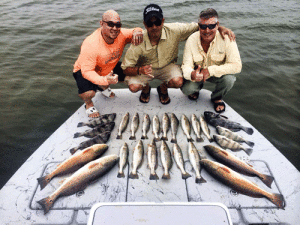As in any real-world situation, there always seems to be some good associated with every bad. The local bays in the Seadrift vicinity are still experiencing fresh water in the upper portion of the water column. As a result, each day of fishing seems to begin at a much slower pace than that which is conducive to this time of the year. Extremely low tide levels have, at times, constricted standard access to many of the preferred wading targets, and strong NNW winds hovering at 20-25 knots have resulted in shades of muddy and murky water conditions. The good side to all this bad, in the wake of the large amount of freshwater runoff of late, is that the freshwater is certainly depositing its fair share of the ever-needed and most welcomed mineral-rich sediment, from which the San Antonio Bay system is definitely benefiting from at this time.
Recovery time from the conditions existing now can be more rapid than one may imagine. NNW blown water can clear promptly in the majority of locations as winds begin their seasonal transition to become S-SSW. The rich silts provided by the freshwater will quickly drop out of the upper water column as the NNW churn subsides, and the less than 1-ft. water visibility shall heal itself to render the more than 2-ft. gorgeous cleanliness that we, and the fish, are much more accustom to.
Meanwhile, and until Mother Nature realizes a necessity to make her overdue cyclical changes, area anglers will need to remain vigilant in their everyday quest for location of clean, green saltwater.
Given the recent runoff conditions, some of the more successful anglers have been those who have incorporated manual monitoring and tracking activities into their daily fishing routine in the form of sampling of area salinity levels in anticipation of capturing real-time environmental changes. To do this effectively, anglers must begin each morning with a strategic process-of-elimination.
Targeted areas for this process should be some of the more notable seasonable areas that have effectively produced in the past under favorable conditions (based upon historical data and fishing logs). To date, however, it has been discovered that an increase in salinity levels is taking place at a painfully slow rate, and resultant of this many anglers are routinely required to cover mass amounts of water acreage during the latter part of each outing. Extraordinarily long runs in late morning and late afternoon hours have produced saltwater locations near some of the southern most portions of the bay system, but they’re sometimes hard to find.
As an alternative to spending what could potentially become an enormous amount of time trying to find true saltwater, anglers should investigate different methods of catching fish within the existing “fresh” conditions. The freshwater runoff is only temporary (hopefully), so anglers can try and make the most of the situation by learning to adapt to these brief changes in the environment by fishing within the water column where the fish will be holding during this time. Freshwater is lighter than saltwater, which means that the “fresh” water will typically be located at the water’s surface, with the saltwater holding at the floor of the bay. So, one commonly effective method for success in these conditions is for anglers to fish deep for their results.
If you are a live-bait enthusiast, try making substantially increasing the length of your leader that runs between the bottom of your popping cork down to your hook – it’s not uncommon to toss live bait hanging 3-5 feet below the popping cork in these conditions. If plastic tails are more your thing, try increasing to a ¼-ounce jighead in order to insure your bait will maintain the preferred depth while you are working it across the bottom. Those are just a couple suggestions that might help in an otherwise desperate freshwater scenario.
Remember to practice CPR when possible on trophy Trout and Reds, “Catch, Photo, and Release”…Guide Chris Martin, Port O’Connor/Seadrift region…www.bayflatslodge.com…888-677-4868

